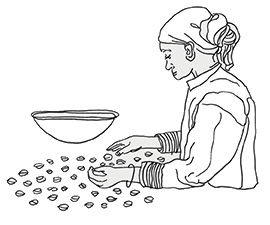About Yosotatu Especial
The community of San Pedro Yosotatu is located in the Mixteca region of the Tlaxiaco district. Most of the producers in the area are bilingual, speaking Mixtec and Spanish. The name Yosotatu is Mixteco for “The sheriff who watches from the top of the mountain.”
To get to San Pedro Yosotatu we first have to fly to Oaxaca and then travel by road for 4 and a half hours. Most of the road is paved, with only the last 30 minutes of the trip on dirt roads.
This small community is located between 1700 and 1900 meters above sea level. The majority of producers that comprise it are small producers with farms between 1 and 2 hectares. Most producers grow the Pluma, Bourbon, and Typica varieties.
Producers usually have their own processing plants at home. Typical fermentation time is between 18 and 24 hours in wooden tanks and drying takes place from 8 and 10 days in petate mats.
Yosotatu is made up of 40 family members and neighbors who sought autonomy and independence from larger organizations. They’re very well organized and work together to schedule collection days and transfer the coffee from Yosotatu to our warehouses in Oaxaca. Aside from coffee, the community’s main cash crop is lumber.
Producers usually keep a distance of 2 meters between rows and 1.5 meters between seedlings. Between each row, producers place a plant that serves to separate the rows and keep the coffee trees apart.
Producers use native trees such as ice cream bean trees and pines to shade their coffee trees. These trees provide not only shade, but also various benefits such as food, ornamentation, medicine, construction materials, and water retention.
The producers’ farms are usually located 15 minutes from the houses, usually right along the road, so the use of mules is unusual. Harvest is carried out between family and neighbors, since most families’ production is small and outside labor is scarce.
Yosotatu is one of the areas that has been hit the hardest by mass migration of young people. When we visit this town, we typically only see children under 15 or adults over 35—young people between 20 and 30 have migrated to other countries or big cities in search of better job opportunities. A clear example of this are the ages of the producers, the youngest of whom are usually between 38 and 40 years old.
Our work in this area started off with a very small group, who, sick of selling their coffee for subpar prices to coyotes and a single cooperative that was dominant at the time, sought a more stable and profitable dynamic. We tried our first samples here several years ago, and since then we’ve built a strong bond with more and more of Yosotatu’s producers, helping them access better prices and more competitive markets. The relationship is built on a foundation of trust and traceability.




